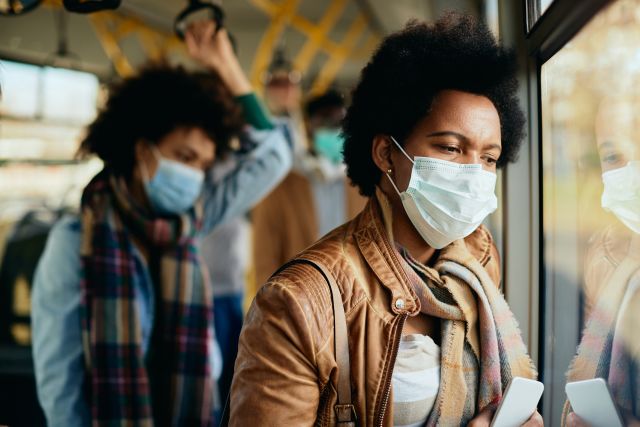Updated on January 27, 2022.
Like wildfire, the Omicron wave emerged with little warning and caused a record-setting surge in new infections, spreading across the United States in just a matter of weeks. The variant quickly overwhelmed hospitals and strained the U.S. supply chain before retreating. In its wake: A weary population with varying levels of immunity desperate to resume a more normal existence.
Omicron whiplash has sparked theories that the fast and furious spike in new infections could have a silver lining: a broader level of protection among the population that brings us closer to herd immunity—and a welcome end to this pandemic nightmare.
This elusive and ever-shifting goal post has been all but abandoned among experts amid the harsh realization that COVID is likely here to stay.
But why?
Why wouldn’t a massive surge in infections that swept across the United States and other parts of the world finally bring COVID to its knees? Why aren’t the credits rolling? Why isn’t this over yet?
More immunity may simply not be enough immunity.
Omicron is on the retreat
Three years into the pandemic, more than 350 million people around the world have had COVID, including nearly 72 million in the United States.
The Omicron wave that began in fall 2021, accounted for an outsized proportion of these infections, setting a record high of 1.3 million new cases on January 10. Since that high, cases are still soaring above levels seen over the past two years. Unlike the original coronavirus strain, which seemed to be less transmissible among children, Omicron appears to spare no one. For most people, health officials warned the question was not if they would be exposed to the variant, but when.
Now, things are starting to settle.
As of January 19, the 7-day moving average of daily new cases fell 5 percent compared to the previous week.
But more people have also been exposed to COVID than ever before. In fact, one estimate suggested that about 86 percent of Americans may have done battle with Omicron by the end of October 2021.
Why herd immunity remains elusive
Herd immunity is achieved once enough people survive infection and/or get vaccinated, making the spread of the disease unlikely—at least for a certain period of time, depending on how long immunity lasts.
When it comes to COVID-19, reaching herd immunity is likely to be a steep challenge due, in part, to its transmissibility. An extensive artificial intelligence (AI) model validated by experimental results on the coronavirus estimates that the Omicron variant, which now accounts for nearly all new cases in the U.S., is 2.8 times as infectious as Delta and about ten times more contagious than the original COVID strain. The easier it is for a virus to spread, the higher the threshold for herd immunity. In other words, if it’s really easy for a disease to spread, like wildfire, more people need to be protected to slow it down.
When it comes to COVID, the more likely scenario: The pandemic eventually ends but SARS-CoV-2 becomes endemic. Like Malaria, it may be constantly present but confined to an area or population, spreading in a predictable way at a predictable rate.
What about hybrid or “super immunity”?
As of January 24, some 75.6 percent of the U.S. population has gotten at least one dose of a COVID vaccine, 63.4 percent are fully vaccinated, and more than 40 percent are boosted.
And although unvaccinated people are four times as likely to be infected and 15 times more likely to die from COVID than those who are vaccinated as of November 2021, breakthrough Omicron cases are more common.
This has given rise to the concept of “super immunity”—the idea that being vaccinated and recovering from infection provides a more robust level of hybrid protection akin to a superpower.
Research that predates Omicron, which has yet to be published or peer-reviewed, suggests otherwise, warning that immunity against the coronavirus among those who’ve been infected erodes over time. On the bright side, those researchers also found that a COVID booster can help restore that protection.
Immunity isn’t uniform or permanent
So, despite a notable spike in the number of recovered people and a sharp increase in the number of people with hybrid immunity, the spread of COVID won’t just grind to an abrupt halt.
Despite continued urges to vaccinate and boost, as of January 25 some 20 percent of Americans eligible for a COVID vaccines still haven’t gotten even one dose.
And the near-term protection that recovery from COVID or hybrid immunity offers may vary from one person to the next and it isn’t a guarantee.
In fact, if we could visualize people’s immunity to COVID, it would likely be as diverse as the population, itself. Immunity is influenced by a range of factors—some inherited or uncontrolled, like age, sex and DNA, while others are dictated by lifestyle and environment, including sleep, hygiene, exercise and weight.
Meanwhile, some young healthy people got three COVID vaccine doses, while others with risk factors for severe disease remain hesitant to vaccinate at all. Some people who were infected a few months ago but have not gotten a COVID booster have a different level of protection than those who were never infected but fully vaccinated and boosted. The list of possibilities goes on.
In short, the wall of immunity against COVID is stronger and taller in some places than others. Pocket of vulnerable people remain in parts of the United States and around the world, leaving the door open for more mutations to emerge. New variants could be even more contagious, more severe, or better able to evade existing vaccines and other treatments.
Finding our way out of the pandemic
There is no doubt that we’re better off now than we were a year ago. But there is no escaping the fact that immunity waxes and wanes with exposure… and time.
The pandemic likely won’t end with the flip of a switch. Instead, the coronavirus may fade into the distance like a receding tide, that ebbs and flows. In time, it may still cause limited outbreaks in places where most people are immune and more widespread disease where most people are not.
When we reach this point, COVID will be considered endemic, like the flu.
So how do we get from pandemic to endemic?
Over time, immunity to COVID among the population through infection, vaccination—or both—along with other preventative measures, will slow the spread of the disease, ultimately reducing the number of hospitalizations and deaths as well.
To be clear, vaccination is the only safe and effective way to gain COVID immunity. The long-term risks of COVID infection, which may include breathing problems, heart complications, an increased risk for diabetes, stroke and more, are still being investigated. But the disease, which can damage the lungs, brain, and heart, has already killed more than 860,000 Americans as of January 21.
What we do know for sure: COVID precautions—vaccinating, testing, masking, hand hygiene and others—are saving lives and helping to prevent the coronavirus from spreading and mutating. But COVID won’t be under control until most people around the world are vaccinated. In the meantime, the more people who continue to follow these preventative guidelines, the sooner we bring the pandemic to an end.






